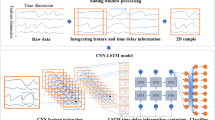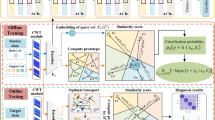Abstract
Background
In the actual industry, due to the small amount of rolling bearing fault data in rotating machinery and the equipment operation under variable operating conditions, there are often serious data imbalance and weak fault signals easily drowned in strong noise, which make it difficult to extract feature information of the bearing health status, leading to a low accuracy of fault diagnosis.
Purpose
The purpose of this paper is to establish a fault diagnosis model based on deep learning, which can efficiently extract the feature information of vibration signals under the condition of data imbalance, and has good fault diagnosis results.
Methods
First, batch normalized convolution and batch normalized dilated convolution are used to build a High-performance Double Pyramidal Fusion (HDPF) module, which increases the perceptual field to extract more adequate and effective multi-scale complex feature information. Batch normalization is used to adjust the feature distribution and eliminate the feature distribution problem caused by data imbalance, the problem which data imbalance causes feature distribution discrepancies is eliminated. Second, a deep Adaptive Residual Decision Fusion (ARDF) module is used to adaptively calibrate the weak feature information, thus improving the adaptive feature learning performance for variable working conditions. Finally, an exponential moving average technique is used to optimize the overall performance of the proposed model by iteratively updating the hyperparameters.
Results
In the noise environment experiment, the diagnosis result of the proposed model for rolling bearing faults is 99.70%, and the diagnosis result for gearbox faults is 99.10%. By comparing with other mainstream intelligent diagnostic models, the experimental results show that the proposed method has better advancement and superiority.
Conclusion
In this paper, a deep intelligent hybrid model for rolling bearing fault diagnosis is proposed, which can achieve good fault diagnosis results under strong noise environment and solve the problem of data imbalance sample under complex working conditions.


















Similar content being viewed by others
References
Yu W, Zhao C (2019) Online fault diagnosis for industrial processes with Bayesian network-based probabilistic ensemble learning strategy. IEEE Trans Autom Sci Eng 16(4):1922–1932. https://doi.org/10.1109/tase.2019.2915286
Chai Z, Zhao C (2020) Enhanced random forest with concurrent analysis of static and dynamic nodes for industrial fault classification. IEEE Trans Industr Inf 16(1):54–66. https://doi.org/10.1109/tii.2019.2915559
Zhao B, Zhang X, Zhan Z, Pang S (2020) Deep multi-scale convolutional transfer learning network: a novel method for intelligent fault diagnosis of rolling bearings under variable working conditions and domains. Neurocomputing 407:24–38. https://doi.org/10.1016/j.neucom.2020.04.073
Lu Y, Li Q, Liang SY (2018) Physics-based intelligent prognosis for rolling bearing with fault feature extraction. Int J Adv Manuf Technol 97(1–4):611–620. https://doi.org/10.1007/s00170-018-1959-0
Zhao M, Jia X (2017) A novel strategy for signal denoising using reweighted SVD and its applications to weak fault feature enhancement of rotating machinery. Mech Syst Signal Process 94:129–147. https://doi.org/10.1016/j.ymssp.2017.02.036
Zhao R, Yan R, Chen Z, Mao K, Wang P, Gao RX (2016) Deep learning and its applications to machine health monitoring: a survey. Mech Syst Signal Process 115:213–237
Jiao J, Zhao M, Lin J, Liang K (2020) A comprehensive review on convolutional neural network in machine fault diagnosis. Neurocomputing 417:36–63. https://doi.org/10.1016/j.neucom.2020.07.088
Li X, Shao H, Lu S, Xiang J, Cai B (2022) Highly-efficient fault diagnosis of rotating machinery under time-varying speeds using LSISMM and small infrared thermal images[J]. IEEE Trans Syst Man Cybern Syst. https://doi.org/10.1109/TSMC.2022.3151185
Cao H, Shao H, Zhong X, Deng Q, Yang X, Xuan J (2022) Unsupervised domain-share CNN for machine fault transfer diagnosis from steady speeds to time-varying speeds[J]. J Manuf Syst 62:186–198
Xin Li, Haidong S, Hongkai J, Jiawei X (2022) Modified Gaussian convolutional deep belief network and infrared thermal imaging for intelligent fault diagnosis of rotor-bearing system under time-varying speeds[J]. Struct Health Monit 21(2):339–353
Lv M, Zhang C, Guo A, Liu F (2021) A new performance degradation evaluation method integrating PCA, PSR and KELM. IEEE Access 9:6188–6200. https://doi.org/10.1109/access.2020.3048492
Shao K, Fu W, Tan J, Wang K (2021) Coordinated approach fusing time-shift multiscale dispersion entropy and vibrational Harris hawks optimization-based SVM for fault diagnosis of rolling bearing. Measurement. https://doi.org/10.1016/j.measurement.2020.108580
Lu J, Qian W, Li S, Cui R (2021) Enhanced K-Nearest neighbor for intelligent fault diagnosis of rotating machinery. App Sci-Basel. https://doi.org/10.3390/app11030919
Kong X, Mao G, Wang Q, Ma H, Yang W (2020) A multi-ensemble method based on deep auto-encoders for fault diagnosis of rolling bearings. Measurement. https://doi.org/10.1016/j.measurement.2019.107132
Zhu J, Hu T, Jiang B, Yang X (2020) Intelligent bearing fault diagnosis using PCA-DBN framework. Neural Comput Appl 32(14):10773–10781. https://doi.org/10.1007/s00521-019-04612-z
Oh S, Han S, Jeong J (2021) Multi-scale convolutional recurrent neural network for bearing fault detection in noisy manufacturing environments. Appl Sci-Basel 11(9):3963
Han T, Zhang L, Yin Z, Tan ACC (2021) Rolling bearing fault diagnosis with combined convolutional neural networks and support vector machine. Measurement. https://doi.org/10.1016/j.measurement.2021.109022
Zhao X, Jia M, Lin M (2020) Deep Laplacian Auto-encoder and its application into imbalanced fault diagnosis of rotating machinery. Measurement. https://doi.org/10.1016/j.measurement.2019.107320
Xing S, Lei Y, Wang S, Jia F (2021) Distribution-Invariant deep belief network for intelligent fault diagnosis of machines under new working conditions. IEEE Trans Industr Electron 68(3):2617–2625. https://doi.org/10.1109/tie.2020.2972461
Zhao B, Zhang X, Li H, Yang Z (2020) Intelligent fault diagnosis of rolling bearings based on normalized CNN considering data imbalance and variable working conditions. Knowl-Based Syst. https://doi.org/10.1016/j.knosys.2020.105971
Li X, Zhang W, Ding Q (2019) Deep learning-based remaining useful life estimation of bearings using multi-scale feature extraction. Reliab Eng Syst Saf 182:208–218. https://doi.org/10.1016/j.ress.2018.11.011
Qian W, Li S, Wang J, An Z, Jiang X (2018) An intelligent fault diagnosis framework for raw vibration signals: adaptive overlapping convolutional neural network. Meas Sci Technol. https://doi.org/10.1088/1361-6501/aad101
Zhang W, Li C, Peng G, Chen Y, Zhang Z (2018) A deep convolutional neural network with new training methods for bearing fault diagnosis under noisy environment and different working load. Mech Syst Signal Process 100:439–453. https://doi.org/10.1016/j.ymssp.2017.06.022
Huang R, Liao Y, Zhang S, Li W (2019) Deep decoupling convolutional neural network for intelligent compound fault diagnosis. IEEE Access 7:1848–1858. https://doi.org/10.1109/access.2018.2886343
Zhang X, Liu S, Li L, Lei J, Chang G (2021) Multiscale holospectrum convolutional neural network-based fault diagnosis of rolling bearings with variable operating conditions. Meas Sci Technol. https://doi.org/10.1088/1361-6501/ac05f8
Han Y, Tang B, Deng L (2019) An enhanced convolutional neural network with enlarged receptive fields for fault diagnosis of planetary gearboxes. Comput Ind 107:50–58. https://doi.org/10.1016/j.compind.2019.01.012
Wang C, Li H, Zhang K, Hu S, Sun B (2021) Intelligent fault diagnosis of planetary gearbox based on adaptive normalized CNN under complex variable working conditions and data imbalance. Measurement. https://doi.org/10.1016/j.measurement.2021.109565
Jia F, Lei Y, Lu N, Xing S (2018) Deep normalized convolutional neural network for imbalanced fault classification of machinery and its understanding via visualization. Mech Syst Signal Process 110:349–367. https://doi.org/10.1016/j.ymssp.2018.03.025
Wang H, Du W (2020) A new K-means singular value decomposition method based on self-adaptive matching pursuit and its application in fault diagnosis of rolling bearing weak fault. Int J Distrib Sens Netw. https://doi.org/10.1177/1550147720920781
Chen R, Zhu J, Hu X, Wu H, Xu X, Han X (2021) Fault diagnosis method of rolling bearing based on multiple classifier ensemble of the weighted and balanced distribution adaptation under limited sample imbalance. ISA Trans 114:434–443. https://doi.org/10.1016/j.isatra.2020.12.034
Yu F, Koltun V, Funkhouser T (2017) Dilated residual networks. IEEE Comput Soc. https://doi.org/10.1109/CVPR.2017.75
Wang J et al (2019) Construction of a batch-normalized autoencoder network and its application in mechanical intelligent fault diagnosis. Meas Sci Technol. https://doi.org/10.1088/1361-6501/aaf319
Xu Z, Li C, Yang Y (2021) Fault diagnosis of rolling bearings using an improved multi-scale convolutional neural network with feature attention mechanism. ISA Trans 110:379–393. https://doi.org/10.1016/j.isatra.2020.10.054
Zou L, Li Y, Xu F (2020) An adversarial denoising convolutional neural network for fault diagnosis of rotating machinery under noisy environment and limited sample size case. Neurocomputing 407:105–120. https://doi.org/10.1016/j.neucom.2020.04.074
Smith WA, Randall RB (2015) Rolling element bearing diagnostics using the Case Western Reserve University data: a benchmark study. Mech Syst Signal Process 64:100–131. https://doi.org/10.1016/j.ymssp.2015.04.021
Huang W, Cheng J, Yang Y, Guo G (2019) An improved deep convolutional neural network with multi-scale information for bearing fault diagnosis. Neurocomputing 359:77–92. https://doi.org/10.1016/j.neucom.2019.05.052
Acknowledgements
This research is supported by the National Natural Science Foundation of China (Grant No. 61763029), the Science and Technology Project of Gansu Province (Grant No. 21YF5GA072).
Author information
Authors and Affiliations
Corresponding author
Additional information
Publisher's Note
Springer Nature remains neutral with regard to jurisdictional claims in published maps and institutional affiliations.
Rights and permissions
Springer Nature or its licensor (e.g. a society or other partner) holds exclusive rights to this article under a publishing agreement with the author(s) or other rightsholder(s); author self-archiving of the accepted manuscript version of this article is solely governed by the terms of such publishing agreement and applicable law.
About this article
Cite this article
Zhao, X., Luo, W. A Deep Intelligent Hybrid Model for Fault Diagnosis of Rolling Bearing. J. Vib. Eng. Technol. 11, 721–737 (2023). https://doi.org/10.1007/s42417-022-00605-w
Received:
Revised:
Accepted:
Published:
Issue Date:
DOI: https://doi.org/10.1007/s42417-022-00605-w




